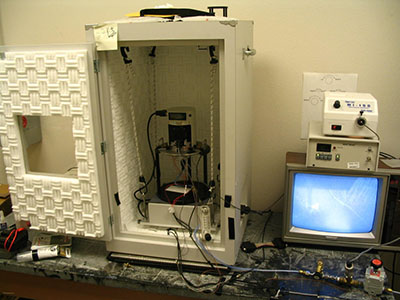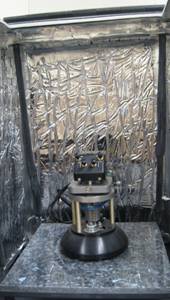Atomic Force Microscope (AFM) – Model PicoSPM from Molecular Imaging

Capabilities
- X-Y range: 25 microns with a resolution of better than 4 nanometers.
- Z range: 7 microns with a resolution of 0.1 nanometers.
- Operation mode: Contact mode : gives surface topography.
- Magnet AC (MAC) mode (‘tapping’ mode) : The tip is driven at its resonance frequency by an electromagnet. In addition to topography, the relative stiffness of the surface can be measured. Also, if the tip is chemically active, then the strength of interaction between the surface and the active species on the tip can be measured.
- Acoustic AC mode: similar to MAC mode, though the tip is driven at its resonance frequency by the Z-piezo.
- Sample Stages:
- Heating stage to 200 °C
- Cooling (Pelitier) stage to -30 °C
- A fluid cell for imaging under a range of liquids.
- An EC cell for electrochemically controlled experiments.
- In addition, we have built a temperature controlled pressure cell which is used for studying the inflation of nanometer thick polymer membranes.
The system also comes with an environmental chamber for studies under inert gas or controlled humidity conditions and a CleanLoad Glovebox for loading and unloading under clean room conditions. Finally, the scanner is mounted in a vibration isolation chamber to reduce ambient noise.
Experimental Application
- Rheological Measurements of the Thermoviscoelastic Response of Ultrathin Polymer Films
- Rheological Property Determination at Surfaces and at the Nanoscale by Nano and Microsphere Embedding
Related Publications
- O’Connell P.A. and McKenna G.B. “Rheological Measurements of the Thermoviscoelastic Response of Ultrathin Polymer Films”, Science, Vol. 307, No. 5716, 1760-1763 (2005).
- S. A. Hutcheson and G. B. McKenna, “Nanosphere Embedding into Polymer Surfaces: A Viscoelastic Contact Mechanics Analysis,” Physical Review Letters, 94, 076103 (2005).
Atomic Force Microscope (AFM) – Universal SPM from Ambios Technology
The USPM AFM unit mainly consists of a microscope unit which is composed of the probe and scanner, an electronic interface unit (EIU), and a computer.

Specifications
- X-Y Range : 40 microns with a pixel resolution of 6.1 angstrom
- Z Range : 4 microns with a pixel resolution of 0.5 angstrom
- Scan Rate : 0.25 Hz to 20 Hz
- Image Resolution: 100 × 100 to 1024 × 1024
Operation Mode
- Contact mode
- Intermittent contact mode
- Lateral force mode
- Phase mode
Related Research
- Distribution of the Surface Mechanical Properties in Nanocomposites by Spontaneous
Embedment of Submicron Particles - Mechanics of DPPC Multibilayers: Surface Properties by Particle Embedment Technique
- Mechanical Properties of PETN Crystal
